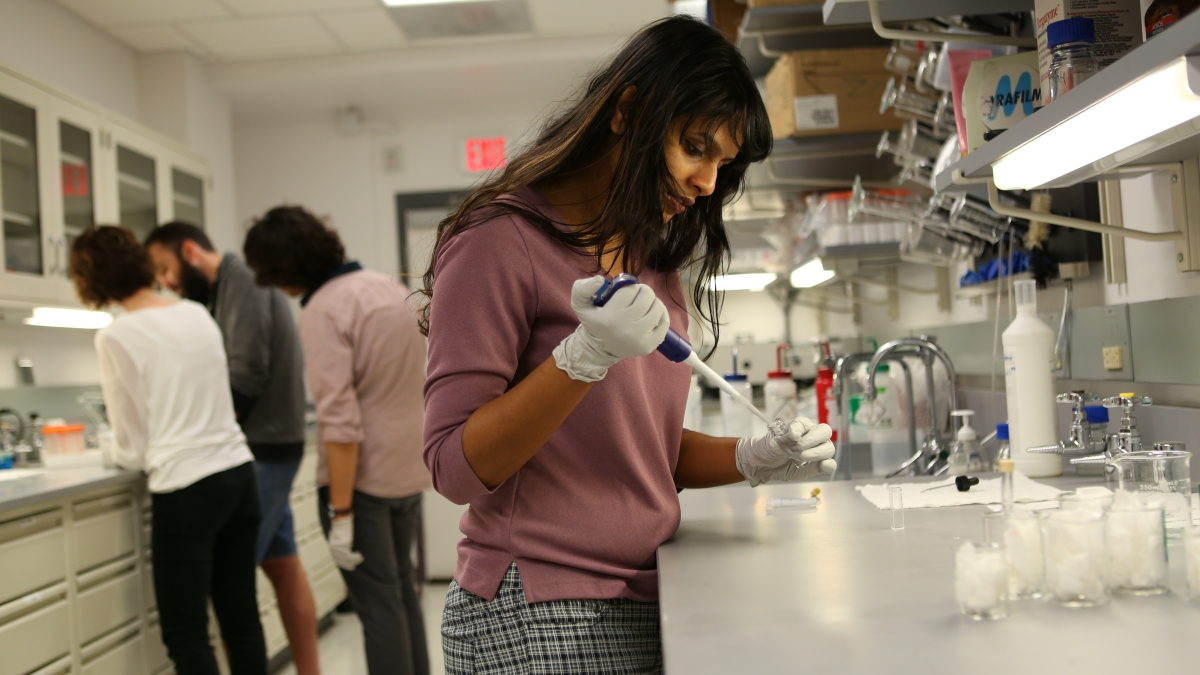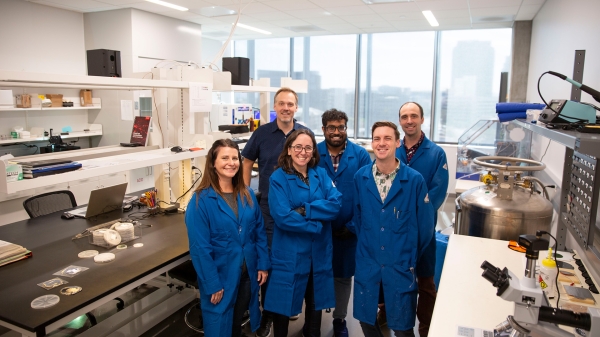Life in motion: ASU biophysics trains students in a young field

Under the mentorship of professor Robert Ros, graduate students conduct research in a biophysics lab at ASU. Image credit: Sara Vaiana, associate professor in the Department of Physics.
The biophysics program at Arizona State University mirrors the field itself in both its interdisciplinary breadth and its youth.
Biology, under one historical name or another, dates back to the beginning of science, at least as far back as Aristotle’s work in physiology and his categorization of plant and animal species. Physics has an equally long history; coincidentally, Aristotle was also the first to call the study of motion “physics,” thereby giving the field the name that has lasted in English to modern times.
But biophysics is a relatively new branch of science, which uses modern principles from both its parent sciences. It is typically defined as the application of physics principles to solve biological problems and study the processes of life by quantifying them.
Biophysicists have made many advancements in health by studying life at every level, from atoms to organisms and beyond. They discovered the DNA double helix and created fluorescent protein tags to detect and identify biomolecules – both of which catalyze progress in preventing and curing disease.
According to Robert Ros, professor of biophysics in the Department of Physics and director of the Center for Biological Physics, biophysics as a field emerged largely out of research being done in different areas of chemistry, specifically physical chemistry.
“Most of our colleagues don’t work in physics departments,” said Ros, who believes the growth of biophysics as a field has come from many areas, not just physics, including: chemistry, biochemistry and biology.
ASU’s biophysics program began in 2013, meaning students who enrolled in the major as freshmen have just begun to graduate as of the 2017 spring semester. This makes biophysics one of the youngest majors offered on the Tempe campus.
Ros said that ASU takes a unique approach to biophysics because most of the faculty involved come from the Department of Physics and the School of Molecular Sciences — both academic units in the College of Liberal Arts and Sciences. But, he noted, biophysics is primarily its own distinct field.
The growing interest in biophysics has catalyzed the creation of the Center for Biological Physics, which hosts renowned scholars from around the world, as well as a bachelor’s degree program for students who want to analyze life patterns with math and physics to make important discoveries.
The bachelor’s degree in biophysics gives students an education in the skills necessary to pursue fields in chemistry and physics. Banu Ozkan, professor and director of the academic program, said the skills learned in the biophysics program are useful in other fields and can provide a leg up in medical school.
Ozkan said the quantitative knowledge students learn in the program is valuable for medical school because it gives them a set of tools that many from less math-intensive backgrounds lack going into medical school.
But she stressed that the knowledge gained in the degree is useful for a variety of graduate school paths because quantitative knowledge is in demand in the life sciences. Furthermore, she said private industry isn’t turning its nose up at biophysics graduates, especially the biomedical industry, which can put their unique skillset to good use.
Recent biophysics graduate Michael Kim can vouch for the value of the quantitative background and the program as a whole. He’s currently working as a research technician in a neuroscience lab at Harvard and recently applied to the university’s neuroscience doctoral program.
“Apparently, a major reason why I was hired was because of my background in biophysics,” Kim said. “The biology research area is turning its focus to more quantitative students. The more quantitative background that biophysics trains students to have is a lot more versatile.”
Kim said he was attracted to the biophysics degree because of the program’s small size and the field’s potential for growth. This lends itself to many opportunities for students to learn alongside pioneers of the science, many of whom are at ASU, such as Petra Fromme, who was awarded the Regents’ Professorship in 2015 for her outstanding contributions to the study of protein structures. Her research could potentially lead to new drugs to fight deadly diseases.
Kim’s advice to students interested in pursuing biophysics as a major: take advantage of the small program’s unique benefits. He said he values the education all the more because of the program’s small size and excellent faculty.
“The really nice thing about a new program like this is the fact that there’s a lot of flexibility to it,” Kim said. “It’s very customizable to your needs.”
More Science and technology

ASU professor honored with prestigious award for being a cybersecurity trailblazer
At first, he thought it was a drill.On Sept. 11, 2001, Gail-Joon Ahn sat in a conference room in Fort Meade, Maryland.…

Training stellar students to secure semiconductors
In the wetlands of King’s Bay, Georgia, the sail of a nuclear-powered Trident II Submarine laden with sophisticated computer…

ASU startup Crystal Sonic wins Natcast pitch competition
Crystal Sonic, an Arizona State University startup, won first place and $25,000 at the 2024 Natcast Startup Pitch Competition at…